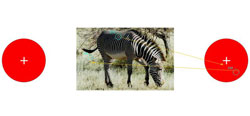Babies can act on purpose early on – eye movements allow new insights in early child development

Targeted selection: Already at the age of six month babies learn fast to activate the correct virtual button. (Numbers indicate the fixation duration on the marked points in milliseconds)<br>Image: FIAS<br>
Utilizing eye-trackers, the researchers measured the eye movements of infants, which the infants were using to control a computer. After they directly looked at a red dot on the screen, with a delay of 0.6 seconds a tone and an alternating animal picture was presented. Six to eight-month-old infants learned very quickly to summon the animal picture by gazing on the red “button”.
And they could not get enough: Within a minute the six-month-old infants summoned the image with their eyes about 15 times. This study was performed by a research team from the Bernstein Focus Neurotechnology (BFNT) Frankfurt, the Frankfurt Institute for Advanced Studies (FIAS) and the Goethe University in Frankfurt.
This research provides new insights into early childhood brain development. Up until now, deliberate infant actions were recorded by other movements, such as pointing or by pressing a switch. The fine motor skills of the arms and legs, however, develop only at the age of eight to ten months to the extent that the children can perform such movements. Therefore, investigations were not possible at earlier ages.
The research team led by cognitive scientist Prof. Jochen Triesch (BFNT Frankfurt, FIAS, Goethe-University) and the development psychologist Professor Monika Knopf (Goethe University) has used devices for measuring the eye movements (eye tracker) of the infants, since children are able to precisely control eye movements from the age of about four months. The experiments have shown that the children use these options intentionally: After just a few trials, the children looked at the position of the screen where the new animal picture was expected to appear before it was actually there. Even on a screen with two identical-looking red buttons they soon found out which one makes the animal picture appear and looked specifically towards it – it seems as if they understood this relationship even faster and more accurately than a control group of adult subjects that performed the same test. The research results were published in the online journal “Public Library of Science One” (PLoS One).
Eye tracking enables researchers to study the targeted actions of infants before the development of fine motor skills and language. “With this method the child’s development can be investigated earlier than before,” explains Triesch, who sees prospects for further work on brain development: “Among other things, we want to know if this method is suitable for even younger babies.”
The Frankfurt Institute for Advanced Studies (FIAS) is a multidisciplinary research institution on the theoretical investigation of complex structures in nature, which was founded by the Goethe-University Frankfurt and is financed by public donors, foundations and private sponsors. In addition to brain research, computer science, biological sciences, chemistry and physics are the focus of their work.
The Bernstein Focus Neurotechnology Frankfurt is part of the National Bernstein Network Computational Neuroscience (NNCN) in Germany. The NNCN was established by the German Federal Ministry of Education and Research with the aim of structurally interconnecting and developing German capacities in the new scientific discipline of computational neuroscience. The network is named after the German physiologist Julius Bernstein (1835–1917).
Original publication:
Wang Q, Bolhuis J, Rothkopf CA, Kolling T, Knopf M, Triesch J (2012): Infants in control: rapid anticipation of action outcomes in a gaze-contingent paradigm. PLoS ONE 7(2): e30884. doi:10.1371/journal.pone.0030884
http://dx.plos.org/10.1371/journal.pone.0030884
Further contact:
Prof. Jochen Triesch
triesch@fias.uni-frankfurt.de
Bernstein Focus Neurotechnology Frankfurt,
Frankfurt Institute for Advanced Studies und
Goethe-Universität Frankfurt am Main
Ruth-Moufang-Str. 1,
60438 Frankfurt am Main
Johannes Faber
Johannes.Faber@bcos.uni-freiburg.de
Press and Public Relations Officer in the
Bernstein Coordination site
Hansastr. 9a
79104 Freiburg
Weitere Informationen:
http://www.uni-frankfurt.de Goethe-Universität Frankfurt am Main
http://www.fias.uni-frankfurt.de Frankfurt Institute for Advanded Studies
http://www.bfnt-frankfurt.de Bernstein Focus Neurotechnologie Frankfurt
http://www.nncn.de Bernstein Network Computational Neuroscience
Media Contact
All latest news from the category: Life Sciences and Chemistry
Articles and reports from the Life Sciences and chemistry area deal with applied and basic research into modern biology, chemistry and human medicine.
Valuable information can be found on a range of life sciences fields including bacteriology, biochemistry, bionics, bioinformatics, biophysics, biotechnology, genetics, geobotany, human biology, marine biology, microbiology, molecular biology, cellular biology, zoology, bioinorganic chemistry, microchemistry and environmental chemistry.
Newest articles

Properties of new materials for microchips
… can now be measured well. Reseachers of Delft University of Technology demonstrated measuring performance properties of ultrathin silicon membranes. Making ever smaller and more powerful chips requires new ultrathin…

Floating solar’s potential
… to support sustainable development by addressing climate, water, and energy goals holistically. A new study published this week in Nature Energy raises the potential for floating solar photovoltaics (FPV)…

Skyrmions move at record speeds
… a step towards the computing of the future. An international research team led by scientists from the CNRS1 has discovered that the magnetic nanobubbles2 known as skyrmions can be…





















